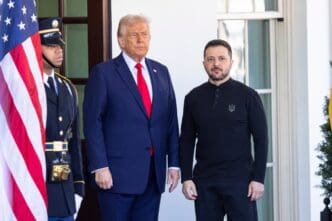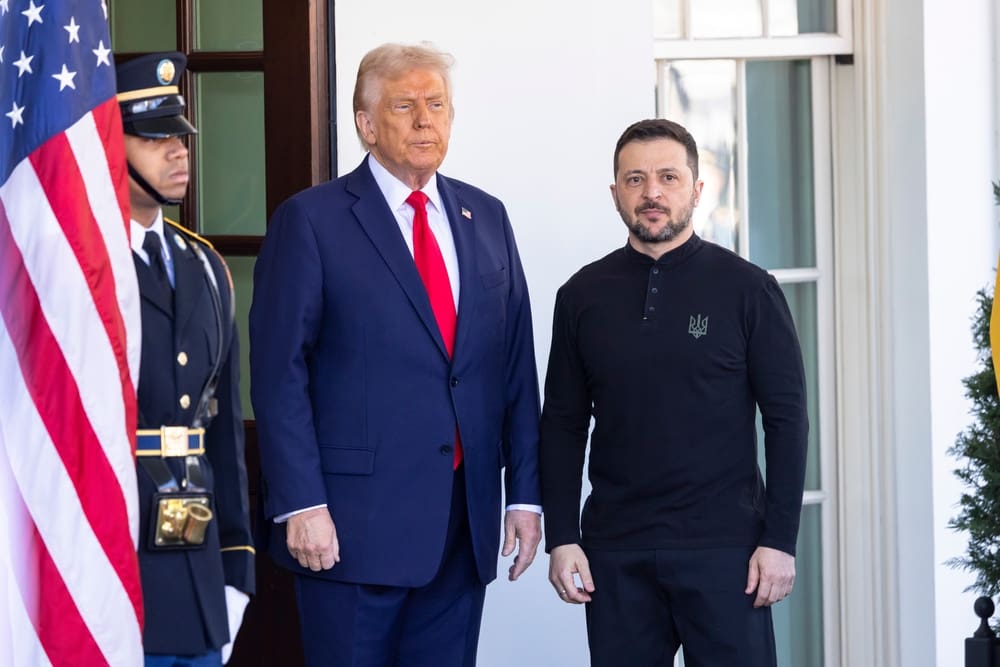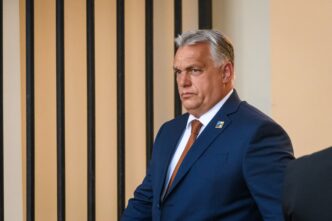WASHINGTON – In a stunning and abrupt reversal of his administration’s policy, President Donald Trump announced a dramatic shift in his approach to the war in Ukraine on Monday, embracing a strategy of renewed military support and threatening massive new sanctions against Russia. The move marks a sharp departure from months of diplomacy that prioritized appeals to Russian President Vladimir Putin and effectively ends a temporary pause on U.S. military aid that had left Kyiv in a precarious position.
The new policy, unveiled during a July 14 meeting with NATO Secretary General Mark Rutte, commits the United States to providing billions of dollars in advanced military equipment to Ukraine, including critical anti-air systems. It also puts Moscow on notice, with the president confirming that crippling new sanctions will be imposed on countries that purchase Russian oil and gas if Putin does not move toward a ceasefire within 50 days.
This dramatic pivot represents a high-stakes gambit to force Putin to the negotiating table through strength, a stark contrast to the administration’s previous strategy. The shift comes after months of escalating Russian attacks on Ukrainian cities and a growing realization within the White House that a diplomatic approach devoid of leverage was failing to produce results.
The change in policy could not be more pronounced. Just months ago, on February 28, President Trump publicly berated Ukrainian President Volodymyr Zelensky in the Oval Office, declaring that Kyiv had “no cards” and must sue for peace on Russia’s terms. That meeting was followed by a temporary halt on all U.S. military and intelligence support for Ukraine. On Monday, Trump handed Zelensky a powerful new set of cards, fundamentally changing the calculus of the conflict.
A New Strategy: Leveraged Diplomacy
The new approach appears to be built on three core components designed to increase pressure on Moscow while bolstering Kyiv’s defenses.
First, the administration will resume the flow of military supplies to Ukraine through an innovative new mechanism. President Trump announced a policy to sell advanced military systems directly to NATO allies, with the explicit understanding that those allies will then transfer the equipment directly to Ukraine. This allows the president to claim he is not directly funding the war effort in the same manner as the previous administration, while still ensuring that Ukrainian forces receive the badly needed supplies to defend their territory.
Second, the policy leverages the newfound unity of the NATO alliance. The announcement follows a successful NATO summit where allies, spurred by Trump, committed to a new defense investment target of 5% of national GDP—a significant increase from the previous 2% target. In a unanimous statement, the alliance declared Russia a “long-term threat” and held Moscow entirely responsible for the war. This display of Western solidarity, combined with a recent conference in Rome where European partners pledged significant economic support for Ukraine, is designed to send a clear message to Putin that he cannot count on a fracturing of the Western coalition.
Third, and perhaps most powerfully, is the credible threat of new sanctions. A bipartisan bill, co-sponsored by Republican Senator Lindsey Graham and Democratic Senator Richard Blumenthal, has been awaiting a green light from the White House. The bill, which now has more than 82 co-sponsors, would impose massive U.S. tariffs on countries that purchase Russian oil and gas, namely India and China. Yesterday, Trump confirmed that 100% tariffs will be imposed on these countries in 50 days if Russia continues the war, a move designed to pressure Moscow’s key economic partners into pushing for a ceasefire.
The Road to Reversal
The administration’s previous approach was rooted in President Trump’s campaign pledge to end the war on “Day One.” Influenced by advisors who suggested the conflict was provoked by NATO expansion, the initial strategy focused on appealing to Putin’s goodwill, offering incentives like sanctions relief while simultaneously taking Ukrainian membership in NATO off the table.
This strategy led to a series of ceasefires proposed by Washington and accepted by Kyiv. However, Russia repeatedly responded to these diplomatic overtures with escalations, launching some of the largest air raids of the war, often within hours of calls between Trump and Putin. These attacks, which appeared aimed at terrorizing the civilian population, were met with defiant Ukrainian counterattacks, including drone strikes deep inside Russian territory against military targets.
After months of this diplomatic inertia, the administration faced a critical inflection point. One option, previewed by Vice President JD Vance in April, was to declare the process a failure and walk away, effectively ceding the military advantage to Moscow as Ukrainian defenses depleted. The other option was to reinforce diplomacy with a credible show of force and commitment.
President Trump has now decisively chosen the second option. The move appears to have been made against the advice of some of his own senior officials. Only last week, the Pentagon had ordered a pause on all military deliveries to Ukraine. When questioned by reporters, Trump claimed to have been unaware of the decision and who made it, before abruptly reversing it. This suggests the president himself is personally invested in the new direction, potentially giving the policy more durability.
Trump perhaps best summed up the logic behind his shift in a comment about Putin on Sunday night: “He talks nice and then he bombs everybody in the evening.” In other words, the president concluded that Putin had overplayed his hand and that appeals to goodwill were futile.
A Test of Wills
This new, more muscular approach comes at a time of immense strain on Russia’s military. By even conservative estimates, Russia has suffered staggering losses in Ukraine, with over one million military casualties, including more than 250,000 dead. It has lost over 10,000 tanks and armored vehicles, and its once-feared Black Sea Fleet has been decimated. The direct military costs are estimated to be over $300 billion and are compounded by hundreds of billions more in frozen assets and GDP losses.
Putin had likely been counting on Trump’s previous policy to continue, allowing Russia to grind down Ukrainian forces who were running out of resources. This new U.S. policy, if sustained, will force a painful recalculation in the Kremlin. With a fresh pipeline of advanced Western military technology and the looming threat of crippling secondary sanctions, Putin will have few options to meaningfully reverse his battlefield losses, making the cost of continuing the war increasingly untenable.
The success of this new chapter in American diplomacy now hinges on the administration’s follow-through and its ability to maintain bipartisan support in Congress and unity with its allies. The message to Moscow is clear: the United States will no longer stand by, and the consequences for continuing the war will only grow more severe. As one former envoy on Russia policy noted, diplomacy with Moscow is often like dancing with a bear; the bear assumes it will control the dance unless the other partner proves itself to be bigger. With this move, the United States is reasserting its status as the bigger bear.








